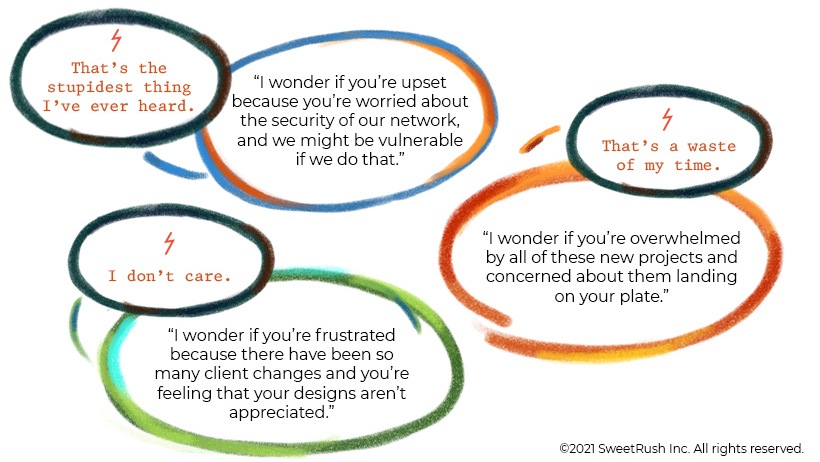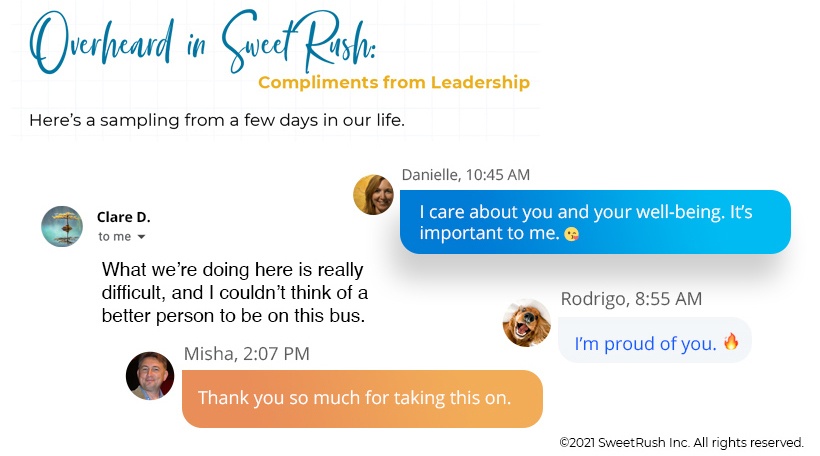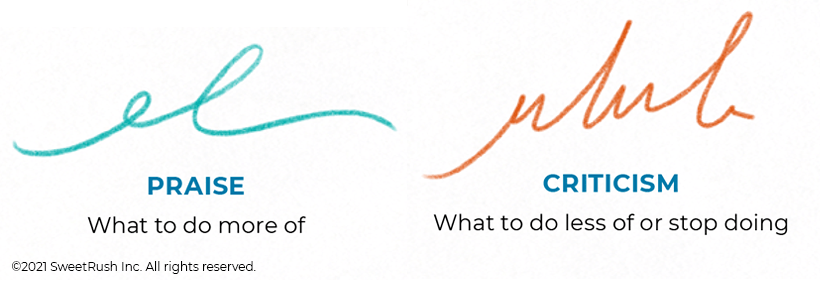Human-Centered Habits for Happier, Healthier Teams
As the pandemic wears on, a second crisis is emerging around our collective mental health. Countless articles, podcasts, and webinars speak to our reduced emotional resilience, or ability to bounce back and even grow, during this prolonged period of adversity and stress.
Our resilience is the sum of multiple factors: our material comfort, our interpersonal relationships, and our physical and emotional health. And there’s one area of life that impacts every one of these factors: our work. Resilient folks report having meaningful work that feeds a larger purpose—and a sense of belonging and connection to our teammates.

With virtual training becoming a constant, rather than a temporary pivot, L&D folks have the mixed blessing of being more in demand than ever. Though it’s gratifying to feel needed, ever-expanding workloads and shrinking project timelines are leaving many of us feeling squeezed.
Those of us at companies that prioritize our wellness and growth, or human-centered organizations, have great examples of communication, collaboration, and self-care strategies that support our emotional resilience. Those of us at traditional companies may have not-so-great examples—or none at all.
But emotional resilience doesn’t just trickle down from the top. With projects extending beyond work hours, we’re spending more time with our teammates than ever before—and the ways we engage each other have an outsized effect on our emotional resilience. That means that great soft skills aren’t just nice to have; they’re vital to our collective quality of life.
We ask our learners to do difficult things every day. It’s time we collectively tackle our toughest learning objective yet: Develop ways of speaking and listening that lift our teammates up—and leave them better off.
Ready to be the resilience you want to see in the world? Take this five-step challenge with your team.
1. Break Free from Reactivity
Is your company ruled by the carrot and the stick? That’s what Gregg Kendrick, Director of Thrive by SweetRush, calls a domination culture: an organizational culture in which people compete to receive limited praise and escape blame and humiliation.
That dynamic activates our fear brain: our brainstem and amygdala, the centers of flight and fight. This fear brain traps us in reactive mode—and it’s exhausting.
Here’s how to be the first to break free—and inspire your teammates to do the same.
- Pause at that flight-or-fight moment (and maybe mute yourself!). Take a few deep breaths and summon your better self. That person lives in your frontal cortex and controls your judgments, risk assessment, and behavior.
- Mentally reconnect to your intention, e.g., “I wanted to share my idea.” Banish any judgment or negative self-talk, e.g., “Everyone’s beating up on me,” or “It was a stupid idea anyway.”
- Mentally name what happened without judgment: “I shared my hesitation, but my team moved on to the next topic without acknowledging it.”
- Describe aloud the physical reaction you’re having, e.g., “Thinking about taking that risk makes my heart pound a little.”
- Share the emotion behind the physical reaction: “I’m feeling scared because I really want this project to go well.”
Naming that feeling of fear, joy, excitement, or anxiety helps to become more human—and focus on connecting rather than competing. When we communicate the experience of feelings in our bodies, we become more human—and set the table for radical, responsible candor (see No. 5).
2. Lean into Empathic Listening
When a teammate is blaming, shaming, or overlooking us, it’s hard not to see them as an adversary. We might be tempted to distance ourselves—or even give them a taste of their own medicine.
That may feel like a power move in the moment, when our brainstem and amygdala are egging us on! But the superpower here is empathic listening, or hearing the human need beneath the unlovable language.
All you’ll need is your frontal cortex—and a sense of wonder. Instead of getting triggered, let yourself wonder: What’s beneath those words? What’s happening with this person at this moment?
It can be hard to reach out to a teammate who’s not at their best. But, like any mindfulness practice, empathic listening is most needed when it’s most difficult. A reactive person is a person in pain or fear, a person in need of care. Empathic listening can answer that need—even if the person can’t appreciate it at that moment.

3. Assume Positive Intent
To quote Linda Fleming, our Chief Operations Officer, “No matter what you hear, no matter what it sounds like, please always assume positive intent.”
That’s a great reminder that we all mean well—even when we type back a terse IM or forget to answer an email.
Rather than read into ambiguous words (or silence!), trust that your teammate has a good reason for their actions (or inactions!). Monosyllabic replies probably indicate that they’re in a meeting and radio silence that they’re swamped. Or maybe they have some unrelated worries pressing on them, and they’ve just forgotten.
That’s when we call up our frontal cortex—and reach out again. Gently follow up, ask for clarification, or let it go. Choosing not to sweat the small stuff is the ultimate way to demonstrate our confidence in our employees’ good intentions.
Sometimes an edgy tone is a product of the moment—or a product of our imagination. On a different day, under different circumstances, we might interpret the same words very differently. Giving a teammate the benefit of the doubt is a great way to weather all of those circumstances.
4. Show—and Accept—Care
It’s never a weakness or an impediment to productivity to choose the kind path—and with a staggering 75% of us reporting a lack of empathy at work, care is urgently needed.[1]
If you have something nice to say—say it!
Many of us are working and collaborating virtually, which means gestures and tone don’t always come through. That’s why it’s so important to verbalize our admiration and appreciation for one another.
Whether we admire a teammate's new hairstyle, idea, or sense of humor, sharing our kind thoughts—no matter how small—can be a great mood booster.
Accept care.
When a teammate offers you a compliment, take it! Even if you don’t think you’re funny, or a great speaker, or amazing at Zoom karaoke, the added confidence just might boost your skills. That’s a hack straight from SweetRush Cofounder Arturo Schwartzberg: He finds himself striving to deserve the compliment—and does better in the process.

Accepting an occasional offer of help can even strengthen our relationships with our teammates. We feel richer when we can give to each other—even when we’re sharing something small. Ben Franklin observed that we like people more when we help them, and this feel-good effect has been confirmed by more recent psychological studies.[2] Practice saying yes—it’s a win for everyone.
Show vulnerability.
Our teammates aren’t our therapists—and vice versa! But sharing our struggles and our celebrations goes a long way in building trust and deepening our relationships.[3]
We’re all human—and sometimes we have bad days or experience anxiety. That’s a perfect time to enjoy a teammate’s empathic listening skills!
5. Practice Radical, Responsible Candor
Practicing care doesn’t mean that we don’t engage in tough conversations; in fact, it enables tough conversations. That foundation of care has to be solid for candor and constructive feedback to land.
Using a common language for candor can take the guesswork out of giving and receiving feedback. We owe our feedback language to Sheila Heen, author of Thanks for the Feedback;[4] Kim Scott, author of Radical Candor;[5] and our Thrive by SweetRush Cultural Transformation team.
Dané Johnson, Thrive by SweetRush Cultural Consultant, advocates for a practice she describes as responsible candor, which begins by considering how a teammate most effectively receives feedback. She explains, “Everyone is different and likes to be communicated with in different ways. And those preferences may shift within the context of their emotional state, current environment, relationship to the communicator, and so on.”
Ready to give radical, responsible candor a try?
First, get clear on the intention behind the feedback you’re looking to give or receive. Beginning our feedback conversation prevents our nerves from tripping us up in the moment—and muddling our message.
One non-negotiable: This intention should always have the other person’s best interests at heart.
For example, if you’re asking a teammate to change their behavior to make your job easier, consider how following this feedback will affect that person. If there’s nothing in it for them, rethink the intention.

The same goes for requesting feedback.
Let’s say you’re interested in some coaching on how to be a better teammate—and you’d like feedback on specific things you could do to be easier to work with.
Next, prepare yourself! All three types of feedback involve both praise and criticism.

Here's how that feedback conversation might unfold, using guidance from Scott[4] and Heen[5]--with the intention always at top of mind!
Ask - What can I do differently to make it easier to work with me?
Listen - Don't interrupt!
Repeat - I'm hearing you say X. Do I have it right?
Clarify - What do you mean when you say X? Do you have an example you can share?
Reward - Thank you so much for your (totally radical!) candor. I'm going to look for opportunities to act on this feedback.
Act - Incorporate the feedback into your practice---and ask for feedback on how it went.
Note the final step, Act. Without action, the feedback conversation remains incomplete.
The practice of radical, responsible candor helps us hold one another accountable for our words, actions, and commitments. After all, when we share a space—even a virtual one—we share responsibility for what happens there. That means being transparent, even about the tough stuff.
Remediation for Resilience
You might be wondering, What if I mess it up?
You will mess up, and it will be okay. You’ve got a team of folks who are listening empathetically, showing care, and assuming that your intentions are positive. They don’t need you to be perfect—they just need you to hang in for this collective challenge.
We L&D folks are used to advocating for our learners’ needs—now it’s time to focus that advocacy on ourselves and our teams. Our moment of need has never been greater.
Rebuild Your Emotional Resilience
Want to learn more about how to communicate, collaborate, and thrive on a human-centered team? Our eBook It’s All About Your People!: Embracing Human-Centered Business, Workplace Culture, and Learning Design shares the brain science and business case for re-creating work as a source of resilience.
It’s a curated collection of the best mindsets, practices, and lessons from our two decades together as a human-centered organization—and decade-plus as a fully remote team. Whether you’re a leader, a manager, or an individual contributor, you’ll find plenty of proven steps you can take today (or anytime!) to be happier and healthier at work.
References:
- https://resources.businessolver.com/c/2021-empathy-exec-summ?x=OE03jO&utm_medium=rich%20media%20article&utm_source=WashPO
- https://www.businessinsider.com/ben-franklin-effect-2016-12.
- https://accoladecommunications.ca/2012/04/22/15-facts-about-trust-definition-types-perspectives-week-2-of-twelve-weeks-to-trust/
- https://www.stoneandheen.com/thanks-feedback
- https://www.radicalcandor.com/

